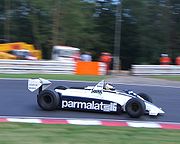
Historic Formula One Championship
Encyclopedia

Formula One
Formula One, also known as Formula 1 or F1 and referred to officially as the FIA Formula One World Championship, is the highest class of single seater auto racing sanctioned by the Fédération Internationale de l'Automobile . The "formula" designation in the name refers to a set of rules with which...
cars from the 1960s, 1970s and 1980s which is sanctioned by the Fédération Internationale de l'Automobile
Fédération Internationale de l'Automobile
The Fédération Internationale de l'Automobile is a non-profit association established as the Association Internationale des Automobile Clubs Reconnus on 20 June 1904 to represent the interests of motoring organisations and motor car users...
, motor sport's world governing body. The championship was recognised by the FIA in 1994 as the only official FIA Historic Formula One Championship and its first season was in 1995.
Class system
The championship is split into four classes according to the vehicle's age and technical specification.| Class | Vehicle eligibility |
|---|---|
| A | 1966-1971 Formula One cars |
| B | Post-1971 non-ground effect Ground effect in cars Ground effect is term applied to a series of aerodynamic effects used in car design, which has been exploited to create downforce, particularly in racing cars. This has been the successor to the earlier dominant aerodynamic theory of streamlining... Formula One cars |
| C | Post-1971 ground effect Formula One cars |
| D | Post-1971 flat bottom Formula One cars |
The HFO Competition features classic Grand Prix racing cars from the 20 year period between 1966 and 1985. During that period there were design innovations and regulatory changes which resulted in significant performance differences and, naturally, there is a vast speed differential between the elder cars such as Jackie Stewart’s Tyrrell 001 and the latter machines like the Steffan Johannsen Tyrrell 012 and Brabham BT49.
To level the playing field, the championship is split into 4 classes according to age and design characteristics of the car. Drivers score points within their particular car’s class and all have the chance to claim the overall FIA Trophy at the end of the season.
The Points
Effectively, there are 4 competitions going on within every race and each provides points for the driver based on his/her placing in the car’s class and the number of competing cars in that class.
3 or More Starters in the Class
1st — 9 points
2nd — 6 points
3rd — 4 points
4th — 3 points
5th — 2 points
6th — 1 point
2 or 3 Starters in the Class
1st — 6 points
2nd — 4 points
1 Starter in the Class
1st — 4 points
Fastest Lap
An additional point will be awarded to the drivers who achieve the fastest lap in each class during the race.
Championship AwardsThe Champion is the driver who scores the greatest points total, regardless of the class in which he/she competes and it is possible for a driver to switch classes during the season.
In addition to overall champion, awards also go to drivers with the highest total of points in each class excluding the overall champion, as follows:
Historic Formula One Historic Cup
The competitor scoring the highest number of points in Class ‘A’
Historic Formula One Classic Cup
The competitor scoring the highest number of points in Class ‘B’
Historic Formula One Cup
The competitor scoring the highest number of points in Class ‘C’
Historic Formula One Sporting Cup
The competitor scoring the highest number of points in Class ‘D’
These are all FIA awards which are presented at an official FIA Historic Awards event.
HFO also presents its own awards at a slightly less formal and usually much more boisterous event as follows:
The Chairman’s Trophy - Introduced in 2009 Tony Smith, this is awarded to the competitor who, in the chairman‘s opinion, exhibits the “Spirit of the Championship”.
The Geoff Richardson Trophy - Provided by one of our engine builders, the trophy is awarded to the best newcomer.
The Nicholson McLaren Trophy - Provided another of our engine builders! This trophy is awarded to the best team.
The Ensign Trophy - Provided by the former CEO of HFO, Mike Whatley. Mike is a something of an Ensign fan having raced an example in HFO very successfully.
Although never a winner, the marque was at its peak during our class B period and fittingly, this trophy goes to the winner of Class B.
The Colin Chapman Trophy - Provided by Clive Chapman and Classic Team Lotus. It is hard to imagine any historic category without a Colin Chapman Trophy but, in HFO’s case, it is equally hard to determine which period it might be applied to since Colin was responsible for so many innovations!
After considering that Class C covers the period when ground effects, carbon fibre chassis and the controversial twin chassis Lotus Type 88 all emerged from Colin’s genius, it was agreed that this trophy would go to the winner of Class C.
Champions
| Season | Champion | Car |
|---|---|---|
| 1995 |  Martin Stretton Martin Stretton |
Tyrrell 005 |
| 1996 |  Michael Schryver Michael Schryver |
Lotus 72 Lotus 72 The Lotus 72 was a Formula One car designed by Colin Chapman and Maurice Philippe of Lotus for the 1970 Formula One season.- Development :The 72 was yet another innovative design by Chapman featuring inboard brakes, side mounted radiators in sidepods, as opposed to the nose mounted radiators which... |
| 1997 |  Bob Berridge Bob BerridgeBob Berridge Bob Berridge is a British racing driver. He won the title in the Historic Formula One Championship series three years in a row. In 1997, he won in a RAM 01 car and the next two years he won in a Williams FW08... |
RAM 01 |
| 1998 |  Bob Berridge Bob BerridgeBob Berridge Bob Berridge is a British racing driver. He won the title in the Historic Formula One Championship series three years in a row. In 1997, he won in a RAM 01 car and the next two years he won in a Williams FW08... |
Williams FW08 Williams FW08 The Williams FW08 was a Formula One car designed by Patrick Head which debuted at the 1982 Belgian Grand Prix held at the Zolder circuit. An evolution of the FW07 that it replaced, the car was used by Finnish driver Keke Rosberg to win the 1982 World Drivers' Championship.The FW08B was a... |
| 1999 |  Bob Berridge Bob BerridgeBob Berridge Bob Berridge is a British racing driver. He won the title in the Historic Formula One Championship series three years in a row. In 1997, he won in a RAM 01 car and the next two years he won in a Williams FW08... |
Williams FW08 Williams FW08 The Williams FW08 was a Formula One car designed by Patrick Head which debuted at the 1982 Belgian Grand Prix held at the Zolder circuit. An evolution of the FW07 that it replaced, the car was used by Finnish driver Keke Rosberg to win the 1982 World Drivers' Championship.The FW08B was a... |
| 2000 |  Martin Stretton Martin Stretton |
Tyrrell P34 Tyrrell P34 The Tyrrell P34 , otherwise known as the "six-wheeler", was a Formula One race car designed by Derek Gardner, Tyrrell's chief designer.... |
| 2001 |  John Bladon John Bladon |
Surtees TS9 |
| 2002 |  Mike Whatley Mike Whatley |
Ensign N175 |
| 2003 |  Mike Wrigley Mike Wrigley |
Tyrrell 012 Tyrrell 012 The Tyrrell 012 is a Formula One racing car that was designed by Maurice Philippe for the Tyrrell team. It was introduced for the season, and was subsequently used in and the first few races of . It was the first chassis built by the team to be composed mostly of carbon fibre, following on from... |
| 2004 |  Rodrigo Gallego Rodrigo Gallego |
March 761 |
| 2005 |  Christian Gläsel Christian Gläsel |
Brabham BT49 Brabham BT49 The Brabham BT49 is a Formula One racing car designed by South African Gordon Murray for the British Brabham team. The BT49 competed in the to Formula One World Championships and was used by Brazilian driver Nelson Piquet to win his first World Championship in .The car was initially designed in... |
| 2006 |  Steve Hartley Steve Hartley |
Arrows A6 Arrows A6 The Arrows A6 was a Formula One car which the Arrows team used to compete in the and Formula One seasons. It was designed by Dave Wass and powered by the Cosworth DFY V8 engine.... |
| 2007 |  Steve Hartley Steve Hartley |
Arrows A6 Arrows A6 The Arrows A6 was a Formula One car which the Arrows team used to compete in the and Formula One seasons. It was designed by Dave Wass and powered by the Cosworth DFY V8 engine.... |
| 2008 |  Mauro Pane Mauro Pane |
Tyrrell P34 Tyrrell P34 The Tyrrell P34 , otherwise known as the "six-wheeler", was a Formula One race car designed by Derek Gardner, Tyrrell's chief designer.... |
| 2009 |  Bobby Verdon-Roe Bobby Verdon-RoeBobby Verdon-Roe Bobby Verdon-Roe is a British racing driver who has raced in various formats of motor sport throughout his career.-Racing Career:... |
McLaren M26 McLaren M26 The McLaren M26 was a Formula One racing car designed by Gordon Coppuck for the McLaren team, to replace the aging McLaren M23 model. The car was designed to be a lighter and lower car than its predecessor, with a smaller frontal area and narrower monocoque... |
| 2010 |  Peter Meyrick Peter Meyrick |
March 761 |

